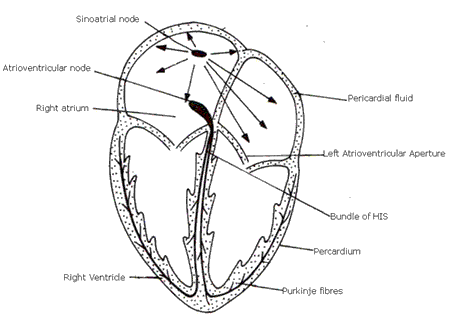Class 10 FRANK Solutions Biology Chapter 7 - Circulatory System
TopperLearning provides you with the complete Frank Solutions for ICSE Class 10 Biology Chapter 7 Circulatory System for exam preparation. Understand why a closed circulatory system works more effectively than an open system. Revise the points to distinguish between a vein and an artery. Learn to answer questions related to the internal structure of the human heart and other chapter concepts with our textbook solutions.
For more practice, refer to our learning resources like sample question papers, ICSE Class 10 Biology practice tests, concept videos and more. We also have a doubts and solutions section on our learning portal to assist you in getting conceptual clarity of the topics in the Biology syllabus.
Circulatory System Exercise 90
Solution 1
Circulatory system in humans:
(a) The right atrium receives deoxygenated blood from all the parts of the body through large veins called vena cava.
(b) When the right atrium is full of blood, it contracts and the blood is forced into right ventricle.
(c) When the right ventricle is full of blood, it contracts and the blood is pumped into the pulmonary trunk.
(d) From right ventricle, the pulmonary artery carries the blood to the lungs for oxygenation.
(e) The oxygenated blood returns to the heart via pulmonary veins that empty into the left auricle.
(f) When the left auricle contracts, the blood passes into the left ventricle by the opening of bicuspid valve.
(g) On contraction of the left ventricle, the blood is pumped into the artery called aorta.
(h) The aorta branches into vessels which transports blood to the heart and all the body parts.
Solution 2
(ii) There is no mixing of deoxygenated and oxygenated blood in the human heart because of double circulation of blood where the blood passes twice through the heart and the right half of the heart is concerned with pumping deoxygenated blood while the left is concerned with pumping of oxygenated blood.
(iii) The closed circulatory system is more efficient than the open system because in closed system the blood flows inside arteries or veins all the time which stops the mixing of blood with other bodily fluids and helps the transport of the blood around the body.
(iv) The left ventricle possess a thicker wall than the right ventricle because it pumps the blood at a higher pressure since blood from the left ventricle goes to all areas of the body while the right ventricle only has to pump blood to the lungs which is a much shorter distance, therefore less pressure is required.
Solution 3

Solution 4
Solution 5
Solution 6
Solution 7
Solution 8
(ii) Phagocytosis
(iii) Haemoglobin
(iv) Auricular systole
(v) Angiology
(vi) Pericarditis
(vii) Tricuspid valve
(viii) Foramen ovale
(ix) Polycythemia
(x) Lubb
Circulatory System Exercise 91
Solution 9
(ii) Foramen ovales
(iii) Nerve
(iv) RBC
(v) Albumin
Solution 11

Solution 12
(ii) (b) Thebasius valve
(iii) (d) Aorta
(iv) (e) Pulmonary arch
(v) (a) Clotting
Solution 13
(ii) (c ) Left ventricle
(iii) (b) Capillaries
(iv) (a) bone marrow
(v) (c ) 120 days
(vi) (a) myogenic
(vii) (a) Eustachian valve
(viii) (c ) ventricle
(ix) (b) 70-80
(x) (c ) Monocytes
(xi) (d) 90%
(xii) (c) William Harvey
(xiii) (b) Spleen
(xiv) (d) all the above
(xv) (d) O
Solution 10
(ii) Ventricles
(iii) Function of bicuspid valve: It prevents the reverse flow of blood from the left ventricle into the left auricle.
(iv) Function of tricuspid valve: It prevents the reverse flow of blood from the right ventricle into the right auricle.

